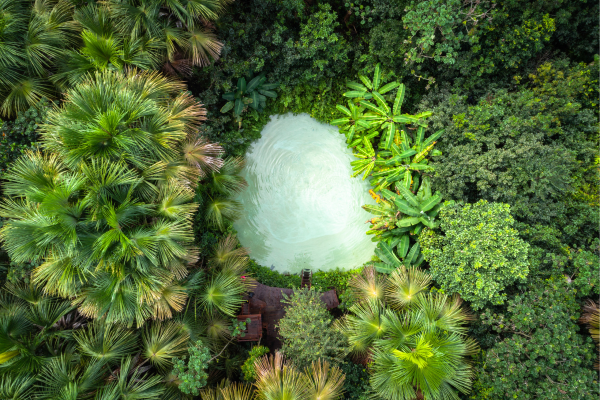Thinking of visiting the Brazilian desert of waters? Here we will reveal all the tips to visit Jalapão and essential information for your itinerary!
You have probably seen beautiful images of Jalapão, this natural paradise of ecotourism in the middle of the Brazilian cerrado. But do you know exactly where Jalapão is, how to get there, and how to organize the tours to see all the attractions?
If you don’t know, don’t worry! In this article, we will explain all the details. After all, the logistics to visit Jalapão are not the simplest, but every effort is worth it to see some of the most beautiful fervedouros and waterfalls in Brazil. Read on and learn everything!

Where is Jalapão and how to get there?
Jalapão is a region of 34,000 km² in the far east of the state of Tocantins that includes several municipalities and various preservation areas. The most famous is the Jalapão State Park, and the main tourist towns are Novo Acordo, Ponte Alta, Mateiros, and São Félix.
In fact, the town of Mateiros is the main base for exploring the attractions of Jalapão. It is located 300 km from the capital, Palmas, where the nearest airport is. Upon arriving in the capital of Tocantins, take the TO-030 road to Santa Tereza do Tocantins, and then the TO-130 road to Ponte Alta.
The route from Palmas to Ponte Alta is all paved, and then it continues on dirt and sandy roads, so travel in a 4×4 vehicle. For those going to Mateiros, the journey continues along TO-255.
Due to these access difficulties, it is highly recommended that you hire a guide with transportation from Palmas. This way, you will worry more about enjoying the place than finding it in the middle of the cerrado.
Book your 3 to 6-day Jalapão State Park Tour with Civitatis and travel stress-free with all logistics taken care of!
What is the Brazilian Cerrado?
The Brazilian Cerrado is the second-largest biome in South America and one of the most biodiverse savannas in the world. Covering approximately 25% of Brazil’s territory, it extends across several states, including Tocantins, Goiás, Mato Grosso, Mato Grosso do Sul, Bahia, Minas Gerais, Maranhão, and Piauí. It serves as a crucial ecological corridor connecting the Amazon, the Pantanal, and the Atlantic Forest.
Characteristics of the Cerrado
The Cerrado is often called an “upside-down forest” because many of its trees have deep roots that allow them to survive long dry periods. The landscape is a mix of:
- Savannas and grasslands, with scattered trees and bushes.
- Gallery forests, which grow along rivers.
- Rocky plateaus and water springs, forming stunning waterfalls and crystal-clear rivers.
It is home to more than 12,000 species of plants, nearly 1,600 species of animals, including jaguars, giant anteaters, maned wolves, capybaras, and macaws. Many of these species are endemic, meaning they are found nowhere else in the world.
Why is the Cerrado important?
- It is Brazil’s main water source – Many of the country’s major rivers, such as the São Francisco, Araguaia, and Tocantins, originate in the Cerrado.
- It helps regulate the climate – Its vegetation plays a crucial role in absorbing carbon dioxide.
- It is rich in culture and traditions – The Cerrado has been home to indigenous communities, quilombolas (descendants of escaped African slaves), and traditional sertanejo (countryside) culture for centuries.
What to see and visit in the Cerrado?
The Cerrado offers incredible ecotourism and cultural experiences, such as:
- Jalapão – Known for its fervedouros, sand dunes, waterfalls, and golden grass handicrafts.
- Chapada dos Veadeiros (Goiás) – Famous for canyons, stunning waterfalls, and mystic energy.
- Serra da Canastra (Minas Gerais) – Home to the São Francisco River’s source and the endangered maned wolf.
- Pantanal (Mato Grosso & Mato Grosso do Sul) – The world’s largest wetland, where you can see jaguars, caimans, and giant otters.
- Cultural and gastronomic experiences – Try local specialties like pequi (a strong-flavored fruit), guariroba (a type of bitter palm heart), and baru nuts.
Visiting the Cerrado is an unforgettable experience, combining breathtaking landscapes, wildlife encounters, and deep cultural heritage. It’s a destination that every nature and adventure lover should explore!
Top Places for Hiking in Brazil
What is the best time to go to Jalapão?
Although the climate is hot in Jalapão throughout the year, it is necessary to pay attention to the rainy season. The dry season runs from May to September, and the rainy season runs from October to April.
The months of August and September are quite dry, so the vegetation will not be as green. The months between May and July are the most recommended since the region will still be green and the weather more pleasant.
What are the best tours in Jalapão?
Due to its vastness, Jalapão encompasses different types of tours. There are fervedouros with crystal-clear water—where you can dive and not sink — waterfalls, hills, dunes, rafting, river beaches, quilombola communities, and many more. Therefore, it may not be possible to visit all of them on the same trip.
So, we will present the main tours so you can organize your travel itinerary to enjoy the Brazilian desert of waters in the best way!
Jalapão Dunes: The golden dunes of Jalapão are a true spectacle. Formed by the erosion of the sandstone rocks that make up the Serra do Espírito Santo, it is one of the most famous spots to watch the sunset.
Fervedouros :The fervedouros are springs of underground rivers that form natural pools of crystal-clear and pleasantly warm water. In the middle of the cerrado, they appear as an oasis.
The water that springs forth has so much pressure that it is impossible to sink in the fervedouros. There are over 100 fervedouros, but only 20 are open for visitation. The entrance fee ranges from R$10 to R$25 (USD 1,75 – 4,36 / EUR 1,66 – 4,16), and sometimes it is already included in the package prices.
Cachoeira do Formiga (Ant’s Waterfall): Recognized for its intense emerald green, Cachoeira do Formiga, on the Formiga River, is one of the most famous waterfalls in the region. The visit costs R$20 (USD 3,49 / EUR 3,33). In addition to the natural massage from the waterfall, you can also relax and enjoy the natural pool that forms after the fall.
Camping is possible nearby, adhering to the Jalapão State Park rule of not leaving any kind of trash behind.
Prainha do Rio Novo (Little Beach of the New River): One of the largest sources of drinking water in the world, the Rio Novo forms several beaches along its banks. The most famous is the prainha do Rio Novo, which is near Cachoeira da Velha. It’s worth noting that the Rio Novo is one of the best spots in Jalapão for a swim.

Cachoeira da Velha (Old Woman’s Waterfall): For adventure lovers, it is possible to go rafting at Cachoeira da Velha! The Cachoeira da Velha, formed by the Rio Novo, is the largest waterfall in Jalapão State Park. It is 100 meters wide and has a 15-meter drop, and due to the force of the water, swimming is not allowed.
There is also a wooden observation platform, but to see the other side of the waterfall, which is formed by two arches, you need to go rafting. The visit is free, and rafting costs from R$170 with local agencies.
Serra do Espírito Santo (Mountain Range of the Holy Spirit): The Serra do Espírito Santo is a rock formation made of sandstone. The trail to reach the long and straight plateau is short, taking about an hour. Since it is an uphill climb, fatigue may set in, but it will soon be forgotten in light of the rewarding view.
Many groups hike the trail to watch the sunrise before heading to other tours in the region. Afterwards, you can proceed to a second viewpoint where you can observe the dunes. The round trip to the second viewpoint is 7 km and takes about 3 hours.

Pedra Furada (Holed Rock): Another spot to watch the sunset in Jalapão is Pedra Furada. It is located 35 km from Ponte Alta do Tocantins on private property. Access is free, and the trail from the road to the stone is quite short, about 5 minutes.
To reach the larger hole, there is another short 10-minute trail, where you can see sunlight rays passing through the entrance formed by the action of the winds.
Stargazing: A free but surprising attraction is stargazing in Jalapão’s sky. Since the towns in the region are quite small and have minimal visual pollution, you can see various constellations with the naked eye.
You can use apps to find the position of each one. And on cloudless days, it is possible to see even the Milky Way.
What do I need to know before traveling to Jalapão?
Jalapão is one of the largest remaining blocks of native vegetation in Brazil and therefore occupies a vast area. Additionally, it is distant from urban centers, and most roads connecting tourist spots are unpaved.
Although many prefer to explore on their own, for Jalapão, we recommend hiring an agency or guide. They will facilitate access, know the best times to visit, and it will be easier to see more than one attraction in the same day.
Keep in mind that there is no public transportation between the attractions, and internet coverage is limited. There are several agencies with varying prices and packages, and you can count on the support of people who know the region.
You will find packages ranging from 2 to 7 days on average, but with a full 5 days, you can visit the main destinations without rushing. Do not expect large hotel chains or luxury inns, but there are several comfortable accommodation options, and many campsites if you want to get closer to nature.
As mentioned, phone and internet signal is scarce, so settle payments before leaving Palmas to avoid issues. Take this opportunity to disconnect and enjoy all the beauty of Jalapão to the fullest.
And our last but not least tip is about travel insurance. Jalapão is an isolated destination where the main attractions are natural. It is a destination for ecotourism and adventure, so having good coverage is essential. Of course, no one ever expects something to happen, but we must be prepared for unforeseen events so they do not negatively impact the trip.

Jalapão is a true hidden gem in Brazil, offering breathtaking landscapes, unique natural attractions, and unforgettable adventures. From the crystal-clear fervedouros to the golden dunes and impressive waterfalls, this remote paradise is perfect for nature lovers and adventure seekers.
Although reaching Jalapão requires planning and effort, the experience is well worth it. Disconnect from the digital world, embrace the untouched beauty of the cerrado, and immerse yourself in one of Brazil’s most extraordinary destinations.


![Read more about the article Brazil Amazon trip: everything you need to know [+ itineraries]](https://doinbrazil.com/wp-content/uploads/2025/07/palafitas-no-Rio-Negro-Amazonas-300x200.png)


Pingback: Things to do in Brazil: a complete Travel Guide - Do in Brazil